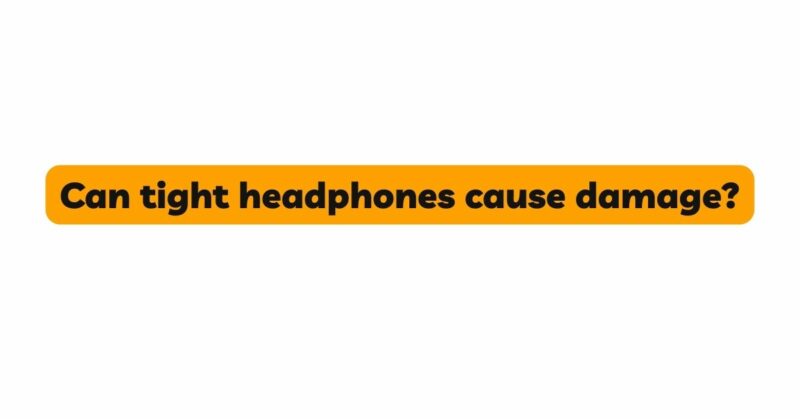Headphones have become ubiquitous in our daily lives, offering a convenient and immersive audio experience for music, calls, gaming, and more. However, improper usage of headphones, particularly wearing them too tightly, can potentially lead to various health concerns and discomfort. In this article, we will explore the potential damage that tight headphones can cause and discuss strategies to mitigate these risks while ensuring a safe and enjoyable listening experience.
- Understanding Headphone Pressure and Fit:
The fit of headphones plays a crucial role in determining the overall listening experience. Headphones that are too tight or loose can both lead to issues. When headphones are worn too tightly, excessive pressure is exerted on the head and ears. This pressure can result in discomfort, pain, and potential damage to sensitive ear structures.
Different types of headphones have varying designs that affect how they sit on or in the ears:
a. Over-Ear Headphones: These headphones feature cushioned ear cups that encircle the ears. If the headband is adjusted too tightly, the ear cups can press too firmly against the ears, causing discomfort and potential harm.
b. On-Ear Headphones: Similar to over-ear headphones, on-ear headphones rest on the ears’ surface. If the pressure is excessive, it can lead to discomfort and pain on the ears.
c. In-Ear Headphones (Earbuds): These headphones fit directly into the ear canal. Wearing in-ear headphones too tightly can cause discomfort and also impact sound quality.
- Potential Damage from Tight Headphones:
a. Ear Pain and Discomfort: The most immediate consequence of wearing headphones too tightly is ear pain and discomfort. The pressure can lead to soreness around the ears or on the earlobes, making listening sessions unpleasant.
b. Compression of Blood Vessels and Nerves: Excessive pressure on the head and ears can compress blood vessels and nerves, leading to headaches, migraines, and tingling sensations.
c. Temporomandibular Joint (TMJ) Issues: Tight headphones can cause tension in the jaw muscles and contribute to TMJ problems, leading to jaw pain and difficulty in opening and closing the mouth.
d. Ear Infections: Wearing in-ear headphones too tightly can create a warm and moist environment in the ear canal, promoting bacterial growth and increasing the risk of ear infections.
e. Tinnitus and Hearing Damage: Prolonged use of tight headphones with high volume levels can lead to tinnitus (ringing in the ears) and potentially permanent hearing damage.
- Choosing the Right Headphone Size and Type:
Selecting the appropriate headphone size and type is crucial in preventing damage caused by excessive pressure. Consider the following factors:
a. Headphone Size: Ensure that the headphone headband or ear hooks are adjustable to fit comfortably without squeezing or pressing too tightly.
b. Earcup and Earpad Materials: Look for headphones with cushioned earcups and earpads made from soft and breathable materials that provide comfort without exerting undue pressure.
c. In-Ear Headphones: Opt for in-ear headphones with multiple ear tip sizes to find the most comfortable and secure fit for your ear canal.
d. On-Ear vs. Over-Ear: If you experience discomfort with on-ear headphones, consider switching to over-ear headphones, which distribute pressure more evenly.
- Practicing Healthy Listening Habits:
To prevent damage caused by tight headphones and ensure a safe listening experience, it’s essential to adopt healthy listening habits:
a. Take Breaks: Avoid extended listening sessions and take regular breaks to give your ears and head a chance to rest.
b. Adjust Volume Levels: Keep the volume at a safe and comfortable level, and avoid the temptation to turn it up to drown out external noise.
c. Use Noise-Canceling Headphones Wisely: Noise-canceling headphones can be beneficial in reducing external noise, but use them judiciously to prevent the need for high volume levels.
d. Ambient Awareness: When wearing headphones in public spaces, maintain awareness of your surroundings, especially near traffic or when crossing roads.
- Regular Maintenance and Cleaning:
Proper maintenance of headphones can ensure their longevity and optimal performance while promoting hygiene:
a. Clean Earpads and Ear Tips: Regularly clean the earpads and ear tips with a soft cloth or mild cleaning solution to remove dirt and bacteria.
b. Replace Worn-Out Components: If the earpads or ear tips show signs of wear or become less comfortable, consider replacing them to maintain a proper fit.
Conclusion:
While headphones offer a gateway to a world of immersive audio experiences, it’s essential to be mindful of how we wear them. Tight headphones can cause discomfort, pain, and even potential damage to our ears and head. By selecting the right size and type of headphones, practicing healthy listening habits, and maintaining them properly, we can enjoy our favorite music and content while safeguarding our hearing and overall well-being. Remember, moderation and comfort are the keys to a delightful and safe headphone experience.


